The Marciano Art Foundation has been the biggest pleasant surprise of 2017. As I’ve mentioned on the blog before, the new museum, funded by the GUESS Jeans fortune, delivers big-time with site-specific special projects from Jim Shaw and Ryan Trecartin and Lizzie Fitch. Those installations are so enthusiasm-inspiring it’s almost easy to overlook the “quieter” collection itself, on display mainly in the third floor galleries.
That would be a mistake, because the collection—the bones of the Marciano Art Foundation—has been curated in such a satisfying , thoughtfully-paced manner that the viewing experience stays engaging throughout. That’s a rarity, unfortunately, in so many hangs of private collections, which tend not to have a specific focus beyond showing off their holdings. Here, though, there are narrative interests evident in the Marcianos’ collection, perhaps highlighted by the apocalyptic nature of the Jim Shaw show and the site-specific “behind-the-scenes” vibe of the Trecartin/Fitch collaboration—namely an interest in social tension or upheaval and works that reveal their process, respectively.
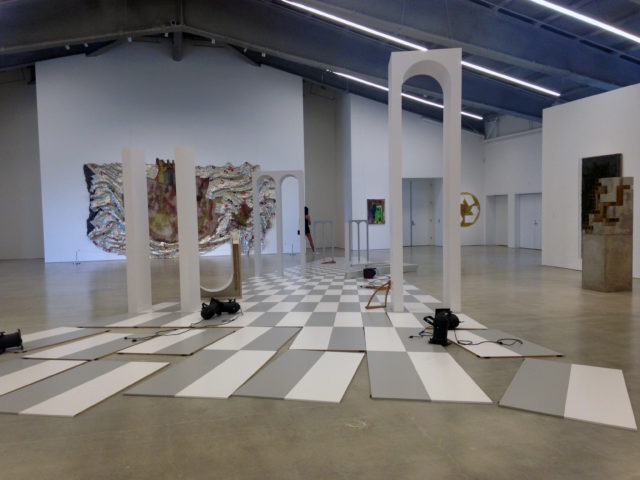 Latifa Echakhch, “Tannhäuser,” 2013.
Latifa Echakhch, “Tannhäuser,” 2013.
It didn’t occur to me why I found the show to be surprisingly good until the final gallery, standing in front of a Latifa Echakhch installation. “Decline of Western Civilization” imagery from Shaw’s work—namely, the neoclassical in a state of ruin—is echoed in Echakhch’s “Tannhäuser,” a recreation of sets from a midcentury production of the opera, seen here in disarray. The piece’s apocalyptic feel struck a chord—it’s nothing if not timely—but it also reminded me of the Bass Museum’s shamelessly tacky One Way: Peter Marino during Art Basel Miami Beach a few years back. That exhibition, of the architect/minor celebrity’s private collection, featured opera sets as well. That show turned me off of the design world’s incursions into art collecting immensely—it had little substance beyond sleek aesthetic and name recognition and felt like a sales pitch for Marino’s practice rather than a museum exhibition. The Marciano Art Foundation, on the other hand, is thematically and stylistically diverse. It feels artist-centric, and certainly engaged with contemporary concerns.
And, crucially, at no point did I feel like I was being sold GUESS Jeans.
Curator Philipp Kaiser has drawn inspiration from the 1931 Walter Benjamin text “Unpacking My Library: A Talk about Book Collecting”, and Benjamin’s enthusiastic embrace of both critical thinking and the joys of seeing objects is evident here. Don’t let allusions to a nearly-nine-decade-old essay about even older things throw you off though—the exhibition features almost exclusively work from the 21st century. Mostly though, the collection is remarkably smart and even more remarkably fun. The artist list here doesn’t offer the unexpected—it’s the usual blue-chip roster—but the quality of the works from those artists is worth noting. Few pieces here feels like soullessly overproduced art fair booth fodder.
A few highlights below:
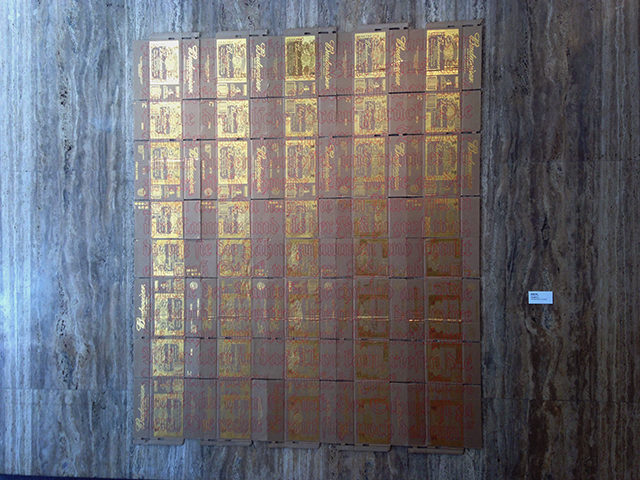 Danh Vo “Pantoffle II,” gold, cardboard, and ink, 2014.
Danh Vo “Pantoffle II,” gold, cardboard, and ink, 2014.
In the lobby, visitors are greeted by a mural-sized Cindy Sherman print from 2010, in which the artist dons ritualistic attire. I’m told it was offered to the Marciano brothers when they bought the building (a vaguely creepy former Masonic lodge) and its dress-up vibe sets the tone for many of the works here, which frequently have a sense of play. David Hammons’ nearby vandalized fur coat works well as its companion. A Danh Vo piece, hung on a wall of the original travertine, recalls the mid-century building’s gaudy gold detailing—here with gold printed directly onto humble cardboard, mimicking a panel of crushed Budweiser boxes.
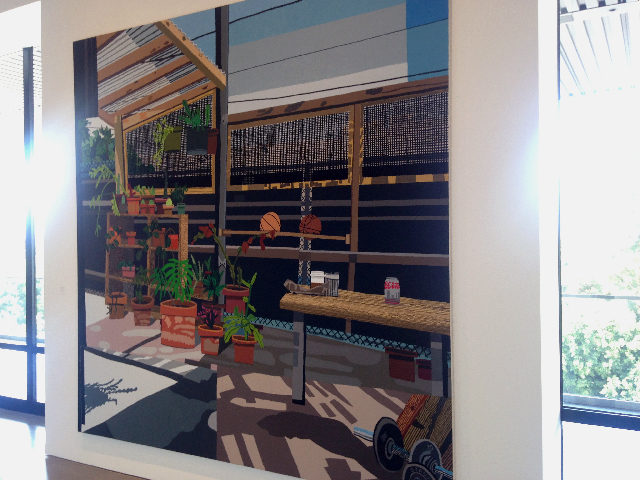 Jonas Wood, “Studio Exterior” Oil and acrylic on canvas 2014.
Jonas Wood, “Studio Exterior” Oil and acrylic on canvas 2014.
The top floor galleries feature an epic balcony with views toward the Hollywood Hills, and some of the work hung in this part of the museum recalls the indoor/outdoor lifestyle the sprawl below is famous for—L.A. painter Jonas Wood’s “Studio Exterior,” for example, depicts an outdoor space with potted plants and a set of gym weights. There’s a casual nature to the work that makes it feel like a space you’d want to hang out in and have a beer with the artist.

Allora & Calzadilla, “Petrified Petrol Pump #2,” limestone, 2010 and Glenn Ligon, “Double America,” neon and paint, 2014.
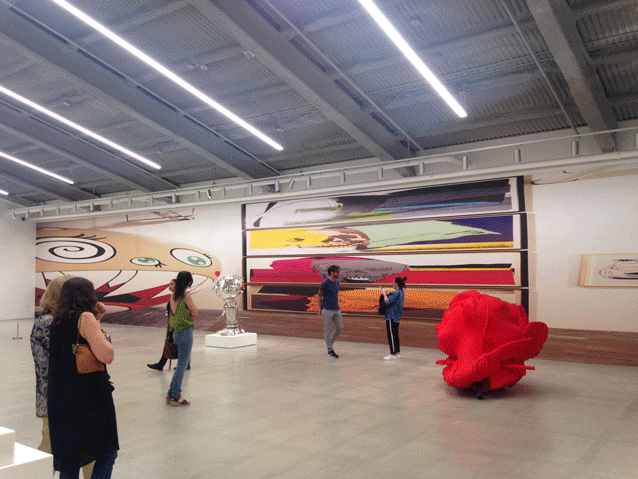
Louise Lawler, “Pollyanna (Adjusted to Fit),” adhesive wall material, 2007/2008/2012 with Takashi Murakami paintings.
I’m not usually a big fan of Takashi Murakami paintings (the sterility of his signature “superflat” style doesn’t appeal to me, personally). This flower diptych, however, drew me in. The cheery anime millefleur patterns are surprisingly textured and distressed up-close, revealing some sort of anxiety behind the smile-til’-it-hurts expressions on the characters. The gallery also features Louise Lawler’s “Polyanna,” which is a photograph of another Murakami alongside other blue-chip staples such as Warhol’s “Skulls”. The print has been stretched horizontally to fit the space—again adding a sense of tension to something that could otherwise be dismissed as wallpaper. So too, does the representation of the Murakami beside the originals. There’s a slight discordance—a quality present in only the best Murakami works.
These pieces from Mike Kelley and Sterling Ruby also speak to a similar type of viewing—both feel like the tabletop make-believe escape of an introverted child. There’s again a notion of trouble in constructed paradise.
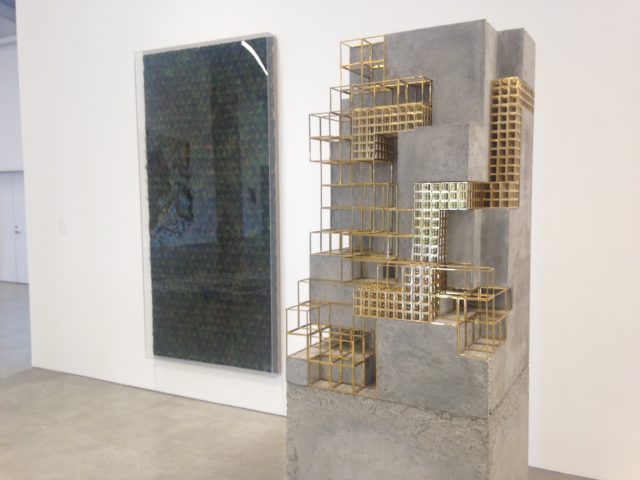 Carol Bove, “Untitled,” Peacock feathers on linen, plexiglass vitrine, 2012 and “Peel’s foe, not a set animal, laminates a tone of sleep,” brass and concrete, 2013.
Carol Bove, “Untitled,” Peacock feathers on linen, plexiglass vitrine, 2012 and “Peel’s foe, not a set animal, laminates a tone of sleep,” brass and concrete, 2013.
That’s a recurring motif in so much of the work here—from an exquisitely crafted Carol Bove sculpture that reminded me of Peter Burr’s dystopian architectures to an epic Goshka Macuga tapestry documenting scenes from the Occupy movement. The latter was originally commissioned for documenta 13. It always feels strange seeing Occupy artwork in the private high-end market—oddly reassuring, on some level, that the protestors’ messages made it to the eyes of the 1%, albeit by several degrees of remove.

Rikrit Tiravanija, “Untitled (Los Días De Esta Sociedad Son Contados,” acrylic and newspaper on linen, 2011.
(THE DAYS OF THIS SOCIETY ARE NUMBERED)

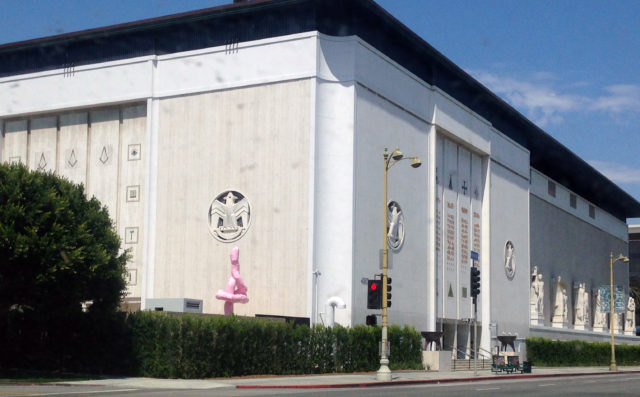
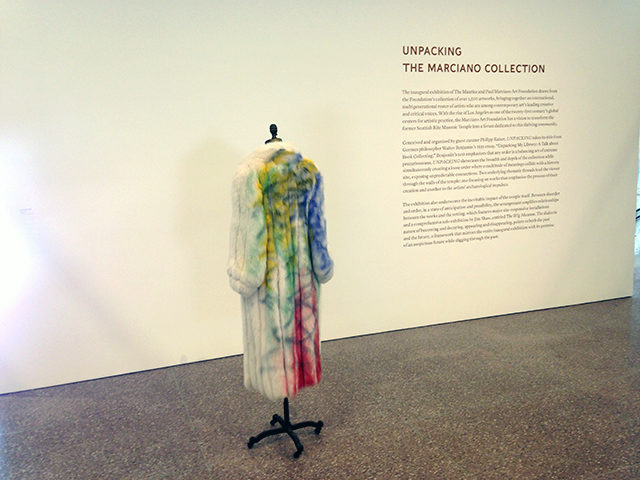


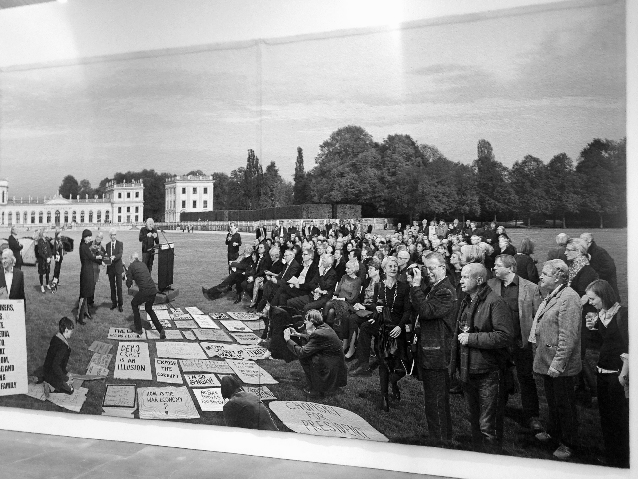

Comments on this entry are closed.